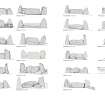Following the launch of trove.scot in February 2025 we are now planning the retiral of some of our webservices. Canmore will be switched off on 24th June 2025. Information about the closure can be found on the HES website: Retiral of HES web services | Historic Environment Scotland
Corrstone Wood, Muir Of Rhynie
Recumbent Stone Circle (Neolithic) - (Bronze Age)
Site Name Corrstone Wood, Muir Of Rhynie
Classification Recumbent Stone Circle (Neolithic) - (Bronze Age)
Alternative Name(s) Mains Of Druminnor; Corr Stone
Canmore ID 17657
Site Number NJ52NW 2
NGR NJ 5101 2711
Datum OSGB36 - NGR
Permalink http://canmore.org.uk/site/17657
- Council Aberdeenshire
- Parish Auchindoir And Kearn
- Former Region Grampian
- Former District Gordon
- Former County Aberdeenshire
NJ52NW 2 5101 2711.
(NJ 5101 2711) Stone Circle (NR) (Remains of) Corr Stone (NAT)
OS 6" map, Aberdeenshire, 1st ed., (1866-70)
A recumbent stone circle, the recumbent stone of which, according to the ONB (1866), is named 'Corr Stone'. Coles (1902) describes it as being 14 feet long, 7 feet wide and 3 feet thick. It has fallen inwards and split into two parts. The three prostrate stones, in the NW quadrant, vary from 7 feet to 9 1/2 feet in length and are about 2 1/2 feet broad. The eastern flanking stone, 8 feet long, 4 feet wide and 20 inches thick, has fallen out of position. The western flanking stone, about 7 feet long and 2 1/2 feet broad, according to the Ordnance Survey Name Book (ONB), was erected by the inhabitants of the surrounding neighbourhood in the summer of 1799 and was still standing when seen by Coles in 1900.
F R Coles 1902; Name Book 1866.
Recumbent Stone Circle, as described.
Re-surveyed at 1/2500.
Visited by OS (RL) 20 September 1967.
This monument is situated in an area of broad-leaved woodland at an altitude of 238m OD.
NMRS, MS/712/52.
This recumbent stone circle has been reduced to six stones, of which only one of the stones flanking the recumbent is still erect. The large recumbent stone on the SW has fallen in towards the centre of the circle, while E flanker has fallen outwards, but the W flanker is erect. The other three stones are on the NW arc. The recumbent stone, which is broken, measures 4.1m in length by 0.65m in thickness and would have stood to a height of at least 2m. The W flanker measures 0.95m by 0.75m and 2.6m in height, while the fallen E flanker measures 2.5m in length. The largest of the three fallen stones on the NW measures up to 2.4m in length.
Visited by RCAHMS (JRS, IF), 5 March 1996.
Field Visit (27 October 1998)
This recumbent stone circle is situated within a deciduous plantation on the summit of the hill above Mains of Druminnor. The traces of rig-and-furrow visible in the plantation to the SW of the circle show that it once stood in farmland, but the ground had been enclosed and planted with conifers by the mid 19th century and now provides a convenient spot for dumping field-gathered stones. One of the dumps occupies a substantial part of the interior of the circle, which measures up to 28m in diameter if the six surviving stones on the western quarter are a reliable guide. They include the recumbent and its flankers on the SSW, but only the W flanker is upright and this was re-erected in the summer of 1799 (Name Book, Aberdeenshire, No. 6, p 85). The recumbent slab (2) has fallen onto its back and now lies in two unequal pieces; before being split it measured about 4.1m in length by up to 1.95 in breadth and would have been an imposing slab when it was upright. The flankers are of similar sizes, the western (1) measuring 2.25m in height, as against the eastern’s (3) length of 2.6m. The three orthostats lying on the W (4–6) have also fallen forwards, each measuring over 2m in length, but in their present positions it is no longer possible tell whether their height and spacing was originally graded. Nevertheless, taken at face value they indicate a relatively large circle comprising the recumbent setting and at least fourteen orthostats. The row of six rectangular wedge sockets cut by stone breakers along the length of orthostat 4 clearly demonstrates the fate of the missing stones, though what may have been one of them (A) lies on a heap of stones and boulders to the W of the circle.
Visited by RCAHMS (ATW, KHJM, ARG, IGP ) 27 October 1998






























